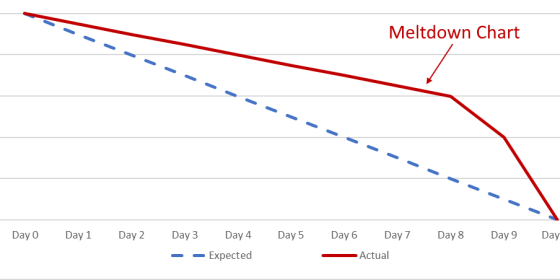From Burn Down Chart to Meltdown Chart

This article is focused on the Burn Down Chart, and what it can tell you about the team members quality of life.
If you are suffering from any of these symptoms, you probably already know the symptoms of the Meltdown Chart:
- Is your team constantly fighting to be ready in time for Sprint Demo?
- Do you tend to “cut corners” to make the deadline? (minimize testing, documentation or other parts of the process)
- Do you feel stressed when getting close to the end of a Sprint – and drained in the beginning of one?
So why do I call this the Meltdown Chart?
Here is a little story you might be able to relate to.
You are almost at the end of a Sprint, and are extremely pressed for time. You need to run very fast and do long hours in order to make it. Everything else has to be placed on hold to get ready for Sprint Demo. As part of the team you have promised to deliver the Sprint, so you can’t let the team down!
While you are fighting at work, your spouse is stuck at home with the kids trying to handle everything alone (preparing dinner, activate the kids, drive them to sports activities, helping them do homework and finally tuck them in).
When you then finally get home after a really long day at work, your partner wants to include you in what has been happening while you were away (the kids were fighting, your mom called, and so on). The only problem is you are so exhausted that you just want to sleep – and therefore don’t really listen.
The next day history repeats itself – you need to get the last things ready for demo, so you work late again – and it keeps going until you finally make it. You are ready for Sprint Demo.
Now I could start mentioning all the things that would probably go wrong during the demo, because you neither had time to do testing or prepare the actual presentation. However, for now I will skip this part, and assume that you succeed in carrying out an excellent demo session.
You then start planning the next sprint and enjoy that you don’t have a gun to your head anymore – you can relax and spend some well-deserved time with your family.
BUT… after completely ignoring your partner for several days, you are no longer living in a happy home. You will really have to make an extra effort to get in good graces. The only problem is that just as things start to improve, you are getting awfully close to the next Sprint demo.
Oh, did I mention that work also sucks because quality is starting to slip and your velocity is constantly decreasing?
So, what is the answer?
There are several reasons why you can end up in this situation. Some typical reasons are:
- You have unrealistic expectations to your own performance
- You have forgotten good engineering practices
- Management is pressuring you to over perform
Either way it all results in a dysfunctional team with poor performance.
For now, I will assume that you are reading this article before your team has gotten stuck in a downward spiral. If you have ended up in a viscous circle, where the entire team is completely drained, you probably need some help from the outside to reboot the process.
To get back on track you first need to start taking your Retrospective session seriously. If you have stopped doing your Retrospective session, you need to re-introduce immediately.
During your Retrospective I recommend to use “Try” and “Keep” session, combined with an impediment analysis. Throughout both parts, your primary focus has to be how you permanently get rid of the Meltdown Chart, so you are no longer fighting to “catch up”.
Most likely, you will need to address more than one thing to get back on track, so it becomes essential to constantly prioritize your efforts. To do that, you then assign business value and estimates to each your identified improvement initiatives, and place your most important ones as top priorities on your Sprint Backlog. At the same time, you should reduce the team velocity in the upcoming Sprint, so the team can operate within normal working hours without lacking behind. This will allow the team to focus on what is broken instead of simply chasing yet another deadline.
You should only consider yourself back on track when:
- Your primary Retrospective initiatives have been handled
- You are doing continuous testing
- You are doing continuous integration
- You are doing continuous documentation
How long you have to spend on cleaning up depends on your situation, but it normally doesn’t take more than a single dedicated Sprint. If you can’t handle everything in a Sprint (or maybe two), it is probably a good idea to get external help.
If you haven’t done Retrospectives before, or have ended in a permanent Meltdown situation, I can only recommend to get help from a professional agile coach. That way you get a solid process execution, acquire new inspiration and are able focus on the issues instead of trying a new process.
When the team has cleaned up, you will experience a higher performance than before – and team members with a higher quality of life ![]()